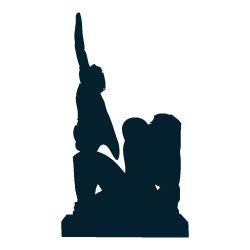Koren Der Harootian For Older Children

Prometheus and Vulture
Koren Der Harootian
Subject: Myths and stories in sculpture
Activity: Drawing your own story
Materials: For drawing: a sheet of paper and graphite pencil. For painting: a brush; acrylic, oil, or tempera paints; and paper, canvas, cardboard, or fiberboard
Vocabulary: Direct carving, figurative, metaphor, mythology, subtractive,
Koren Der Harootian was born in Armenia during a time of persecution by the ruling Turks. His family fled to the United States and settled in Worcester, Massachusetts, a community where many Armenian immigrants were living. Later, after spending some years in Jamaica, he settled in New York and Philadelphia. He carved wood and bronze and was part of the “direct carve” movement‒carving done using only basic hand tools. Prometheus and Vulture was sculpted in marble using the “direct carve” method.
Der Harootian often used classical and religious subjects as metaphors in his mostly figurative works. According to ancient Greek mythology, Prometheus disobeyed Zeus, the king of the gods, and secretly gave humans skills and knowledge relating to subjects as diverse as the alphabet, art, astronomy, and medicine. Maybe most importantly, he gave humans fire. In punishment for this last act, Zeus chained Prometheus to a mountaintop where a vulture would eat his liver every day. At night, it would grow back again. After thirteen human generations, the hero Hercules saved Prometheus.
What is the purpose of storytelling?
Why do you think Der Harootian chose to make art based on this myth?
Why do you think he chose a direct carving technique? How might this technique relate to the myth of Prometheus and Zeus?
Think of one of your favorite stories. It can be a made-up story or one that happened in real life. Think of a people or characters that are involved in this story. Then create a drawing or painting that depicts one of them.
Der Harootian was a self-motivated learner. He taught himself how to use watercolor first, and then, when he went to Jamaica, how to carve in wood.
Most sculptors who use the direct-carving method do not create clay models of their artwork before sculpting. These artists focus more on the natural qualities and textures of their material, instead of worrying about creating a perfect skin-like texture or exact image.
In the original story, an eagle would eat Prometheus’ liver each day. However, in the sculpture Der Harootian depicted a vulture. Why do you think he would choose this bird instead? What are the similarities and differences between the two?
Direct Carving ‒ A twentieth-century term used to describe a less-planned approach to carving in which the sculptor carves the finished sculpture without using models, or maquettes.
Figurative ‒ (Of an artist or work of art) Representing forms that are recognizably derived from life
Metaphor ‒ The use of one kind of object or idea in place of another, suggesting a likeness or analogy between them
Mythology ‒ Stories dealing with the gods and legendary heroes of a particular people Subtractive ‒ (In sculpture) The artist starts with a larger piece of material and removes some of it until only the desired form remains
